#sukhavati
Explore tagged Tumblr posts
Text

Heart Sutra ~ A sutra that describes “The Heart of the Perfection of Wisdom" (3)
The merits of “Prajna-paramita Hridhya Sutra” – Part 2 [Part 1]
There is also a commentary that describes as below:
‘When Xuanzang crossed over Silk Road to India, he traveled with his shadow as his companion along the way, where there were no birds to fly, no beasts to meet and no water plants to be found. During this time, Xuanzang was chanting the ‘Heart Sutra’ with Avalokitesvara Bodhisattva in mind. At one point, he encountered a group of evil demons and was surrounded in front and behind. He prayed to Avalokitesvara Bodhisattva for help, but this had no effect and the demons did not leave. Next, believing in the power of the Heart Sutra, he recited it, and the demons fled at once. Thanks to this, Xuanzang was spared.’
It emphasises that the efficacy of the spiritual experience lies in the scripture itself and that reciting the scripture orally is an excellent manifestation of the spiritual experience. And although Avalokitesvara Bodhisattva appears in the Heart Sutra and is the embodiment of Prajna-paramita, they too is only a character in the Heart Sutra.
This commentary also states that if the Prajna-paramita Sutra is recited, it has miraculous efficacy of detoxification, curing illness and expelling disasters, as well as annihilating the sins and karma of previous lives.
Furthermore, it says that while it is beneficial to recite and memorise the Heart Sutra alone, if this sutra is copied and given to others to explain, the merit is greater and some spiritual benefit can be gained. In the "Great Storage of Scriptures", the ‘Pure Land Rebirth Mantra’ is given at the end of the translation annotation. And it is written that if the mantra ‘Gate Gate Paragate Parasamgate Bodhi Svaha’ at the end of the Heart Sutra is chanted together with it, this is a spiritual experience that will lead to swift rebirth in the Pure Land of Ultimate Bliss (Sukhavati). In other words, you can die peacefully.
These are just a few, and most commentators state through their annotations that the spiritual experiences of the Heart Sutra are extremely manifest. [Click here to continue]

般��心経 〜「智慧の完成」の精髄を述べる経典 (3)
『般若波羅蜜多心経 (梵: プラジュナーパーラミター・フリダヤ・スートラ) 』の功徳 〜 その2(これまで)
“玄奘三蔵がインドに渡るとき、途中は飛ぶ鳥もなく、獣に出会うこともなく、水草もないところを自分の影を伴友にして行った。その間、三蔵は観音菩薩を念じ『般若心経』を口ずさんでいた。あるとき、悪鬼どもに遭遇し、前後を囲まれてしまった。そこで彼は観音菩薩の助けを念じたが、一向に効きめがなく、悪鬼は退散しなかった。次に『般若心経』の威力を信じ口誦すると、悪鬼どもは一目散に逃げ去った。お陰で三蔵は難を免れた。“という『般若心経』の霊験を玄奘三蔵が受けたことを記している注釈書もある。
観音菩薩は『般若心経』の中に出てくる菩薩で、般若波羅蜜多の体現者ではあるが、その菩薩も所詮、『般若心経』の登場人物にすぎなく、霊験の効能は経典そのものにあり、経典を口誦することがすぐれた霊験を表すことを強調している。
この注釈書には『般若心経』を読誦するならば、解毒、治病、除災などの霊験もあり、先世の罪業も消滅する効能が見られるとも述べている。
さらに、『般若心経』を一人だけで読誦し記憶したりすることも効験があるが、この経典を写経して、それを他の人に与え、説明するならば、その功徳は多大で何らかの霊験を受けるはずだとも述べている。
その他にも、卍続蔵経(大蔵経)には、往生浄土神呪という真言を訳註の最後に示し、その真言と一緒に『般若心経』の末尾にある「ギャーテー・ギャーテー・ハーラーギャーテー・ハーラーギャーテー・ボージー・ソワカ」という真言を唱えると、速やかに極楽浄土に往生できる霊験を得ると記されている。つまり、安らかに死ねるということだ。
これらはほんの一部に過ぎず、ほとんどの注釈者たちは『般若心経』の霊験の効き目は著しく現れることを、註釈を通して述べている。
(続くはここをクリック)
#zen#mindfulness#buddhism#buddha#wisdom#philosophy#nature#art#heart sutra#xuanzang#journey to the west#spiritual experience#spiritual power#sukhavati
108 notes
·
View notes
Text

#buddha#buddhist#buddhism#dharma#sangha#mahayana#zen#milarepa#tibetan buddhism#thich nhat hanh#amitaba buddha#Namo Amituofo#amitabha#sukhavati#dewachen#enlightenment spiritualawakening reincarnation tibetan siddhi yoga naga buddha
74 notes
·
View notes
Photo
false

Amitabha and Guanyin are not only the focus of devotion for practitioners of Pure Land Buddhism; they are also exemplars for the community. Just as Amitabha, the Buddha of Infinite Light, made 48 vows aimed at alleviating the suffering and aiding the spiritual progression of all sentient beings, Pure Land Buddhists are expected to make similar vows. In fact, displaying such karuna, or compassion, is one of the primary signs that a person has gained the absolute faith necessary for rebirth in Sukhavati.
Ultimately, since this world is still very far from being a Pure Land, our own efforts are not sufficient to overcome the myriad sources of suffering. Liberation requires that one be reborn in a Pure Land such as Sukhavati, which can only occur through receiving the compassion of Amitabha, who from his infinite store of merit transfers the necessary amount to an individual. Not only a great Buddha like Amitabha, but anyone with a store of good deeds can transfer that merit to benefit others.
Whether by maintaining a vegetarian diet, freeing animals, providing disaster relief or medical care, distributing Buddhist literature, or chanting for the benefit of others, the activities of Pure Land Buddhists are geared to improve the conditions of this world so that all people can attain enlightenment. Ideally, these compassionate acts will make this world a Pure Land and obviate the need for rebirth in Sukhavati.
#avalokiteshvara #thangka #thangkapainting #thangka #thangkaart #tibetanbuddhism #chenrezig #sukhavati #pureland #ommanipadmehum #bodhisattva
#불교 #手工的 #唐卡 #唐卡画 (at Nepal) https://www.instagram.com/p/Caql_MavqcJ/?utm_medium=tumblr
#avalokiteshvara#thangka#thangkapainting#thangkaart#tibetanbuddhism#chenrezig#sukhavati#pureland#ommanipadmehum#bodhisattva#불교#手工的#唐卡#唐卡画
9 notes
·
View notes
Text
ROUND 1, Part 14
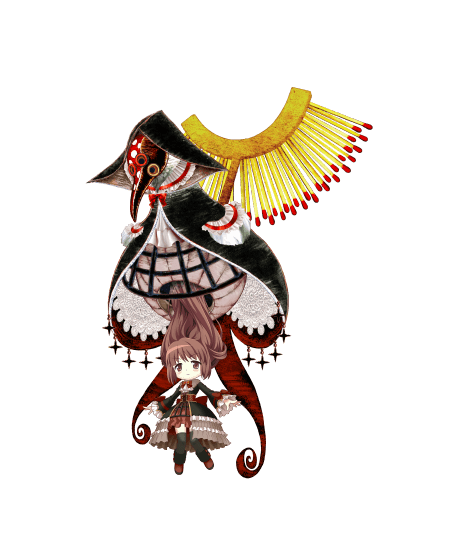
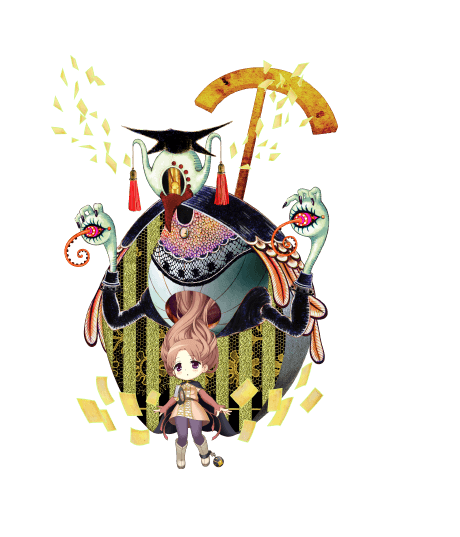


#Round 1#Magia Record#Pennen Nolde#Pennen Nenemu#Shitori Egumo#Sukhavati Smriti#Touka Satomi#Nemu Hiiragi#Ui Tamaki#Kagome Satori
31 notes
·
View notes
Text
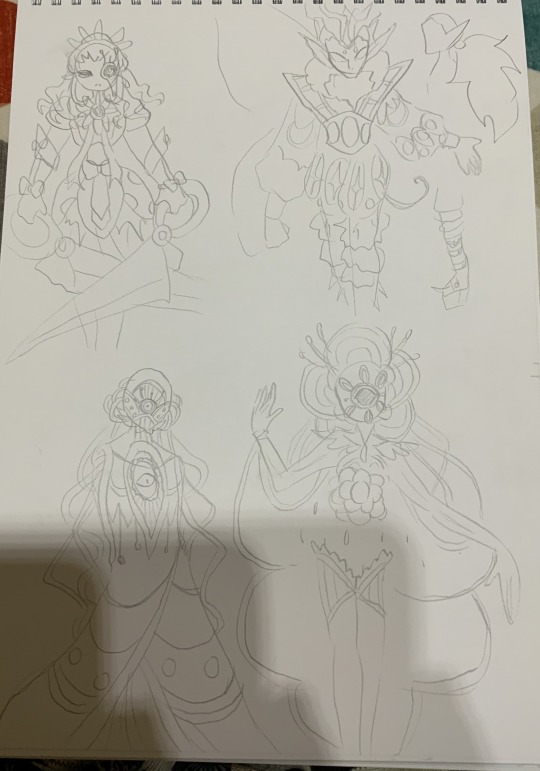
Magical witch designs for Hepialidae (Kushu’s doppel), Sukhavati Smriti (Kagome’s doppel) and a sewing and springtime fusion
Hepialidae was one I really didnt want to do hence why shes been put off for so long… but i think she came out cool, may need a touch up but still cool. Really like Sukhavati though, she looks horrifying and i love it
#madoka magica#puella magi madoka magica#pmmm#witch#madoka magica witch#my art#magia record#Doppel#magical witch au#Hepialidae#sukhavati smriti#witch of sewing#witch of springtime#mobage
20 notes
·
View notes
Text
Title: 童祭 ~ Innocent Treasures (Kid's Festival ~ Innocent Treasures)
Arrangement: 徳南 & 九宝時
Album: 闡提宗祀 ~ Offering to The Sukhavati
Circle: Demetori
Original: Kid's Festival ~ Innocent Treasures
#touhou#touhou project#kid's festival ~ innocent treasures#ZUN#touhou music#changeability of strange dream#闡提宗祀 ~ Offering to The Sukhavati#徳南#九���時#demetori
44 notes
·
View notes
Text

these kirby attack names are getting very 2hu-y
#hell sukhavati new world slash flash is only a couple kanji off from being a youmu spellcard#kirby#touhou
6 notes
·
View notes
Text
one thing i really like about buddhism--particularly mahayana buddhism--is that it understands context, so in my mind it's a very "human" religion. mahayana doesn't tell you to live up to impossible standards but rather, to actually attain what was once thought impossible through whatever means you have. by any means necessary is very applicable to mahayana buddhism.
in the lotus sutra, the buddha states something along the lines of "if a person needs an arhat to be saved, i will appear in the form of an arhat" and proceeds to list down several other forms they might take to save someone, right down to "if they need a common person to be saved, then i will appear in the form of a common person." now, buddhism has been soteriological from the start (it's all about emancipation from the wheel of rebirth after all) but that sutra passage only really served to highlight the major message of the entire sutra: the use of skillful means.
so to me this means buddhism accepts contexts. it doesn't require you to do 180,000 prostrations, it doesn't require you to be a perfect peerless meditative god, it doesn't require you anything that you cannot do at all. it doesn't matter: you will become a buddha all the same. that last bit makes it even better: since in buddhism emancipation means becoming a buddha, when sakyamuni "saves" you he only really supercharges your enlightenment so you can get to it easier, or if another buddha saves you (like amitabha) he whisks you off to his pure land sukhavati so that you can focus a thousand kalpas on just enlightenment without having to be hungry, thirsty, or oppressed.
the majority buddhism in my country is mahayana--it used to be some form of esoteric buddhism during the classical period but that has long since vanished away. though the fact that there has been avalokitesvara images found somewhere in batangas makes it a very spiritual thought to become a buddhist in a country that has partial buddhist roots.
it's mahayana because the buddhism that was brought back here during/after colonization was chinese buddhism. which is dominated by amitabha/pure land buddhism. now one of the most important deities/bodhisattvas in chinese buddhism is guanyin 觀音 (bodhisattva of compassion, who is a strange sinicized version of avalokitesvara). you'll still find her statues in the philippines, especially in parts most concentrated with chinese immmigrants. in one corner of binondo you will see a street shrine with guanyin, mother mary, and jesus christ beside each other, and with passersby offering incense to all three of them.
so since guanyin (who, by the way, is sometimes syncretized to essentially be "chinese mama mary" because religion in religious countries is very bumfuck evades taxonomy) is the most popular bodhisattva in the PH, when tibetan lamas arrived here to teach vajrayana, they adapted a lot of chenrezig rituals even though chenrezig isn't really overtly huge in tibetan buddhism. so now when you go to vajrayana pujas in manila, they almost always have some semblance of chenrezig invocation, and its common to have chenrezig pujas.
another upaya-kaushalya thing i noticed is that buddhism doesn't really do like mass every sunday. but since filipinos have been doing sunday mass for around 300 years now they adapted and now we have sunday pujas because the common filipino expects some sort of religious commitment on sunday
i think buddhism could be a huge boon to socialist movements. cutting through the ego, emphasis on emptiness (that is, nothing has inherent nature, which is essentially mystical materialism), and an emphasis on a sort of helping each other to gain merit would really benefit everyone. especially since unlike christianity they don't force other local religions or local people to change for them, but rather, they retrofit themselves into the local space, adopting the principle of skillful means to help everyone realize their buddhahood.
130 notes
·
View notes
Text
April 20, Beijing, China, National Museum of China/中国国家博物馆 (Part 5 – Ancient Chinese Porcelain exhibition/中国古代瓷器展):
First post of the year, gotta start with something good: this is a rather famous vase from Qianlong era of Qing dynasty (1644 - 1911). It's made in the suantouping/蒜头瓶 (lit. "garlic-head vase") shape, and decorated with falangcai/珐琅彩 (basically cloisonné but done on porcelain instead of metal). The design features a nice combination of traditional Chinese chanzhihua/缠枝花 motifs (traditionally this continuous plant motif symbolizes longevity) and European art influence, specifically from rococo. This is interesting as rococo was also influenced by Chinese porcelain, making this vase another example of cultural influence going both ways.

As mentioned in my previous announcement post, my visit to the National Museum of China was very brief, everything took place in the span of one day (plus traveling to and from Beijing), please pardon the picture quality.
And from here on I will be going in chronological order. Below is an urn from the Northern Dynasties (439 - 581 AD). This urn was decorated with lotus petals all around, and was specifically a type of grave good, not made to be used by the living. Lotuses are a commonly used symbol in funerary rites due to its association with Sukhavati (Sanskrit: सुखावती; referred to as "极乐世界" or "Land of Bliss" in Chinese) in Mahayana Buddhism.

Another urn, this time from the Sui dynasty (581 - 618 AD) Shouzhou kiln/寿州窑. This urn may also have been grave good, as evidenced by the numerous Buddhist symbols all around.

Left: a small Sui-era vessel, found in a tomb. It's probably also a grave good, because of its pointy design (imagine holding that).
Right: a group of small Sui-era grave goods, these were tiny and adorable


In the middle is a Tang dynasty (618 - 907 AD) pitcher, made by the Lushan kiln/鲁山窑. This pitcher displays Lushan wares' characteristic blueish glaze, where the blue comes from different concentrations of iron oxides.

Left: a Northern Song dynasty (960 - 1127) white-glazed wine vessel called a meiping/梅瓶 (lit. "plum vase"), but in Song dynasty it was called a jingping/经瓶.
Middle: a Northern Song era white-glazed Ding ware/定窑 plate decorated with the double fish motif.
Right: this one is pretty cute, it's a container for weiqi/围棋 pieces that's shaped like a drum, made by Yaozhou kiln/耀州窑.



Left: forgot to take a picture of the placard, but my guess is that it's a bamboo-necked celadon-glazed Longquan ware/龙泉窑 vase (I might be wrong).
Right: a small Southern Song dynasty (1127 - 1279) Ge ware/哥窑 bixi/笔洗. Bixi are containers used to rinse traditional brushes. This bixi has the crackled glaze that's characteristic of Ge wares.


Left: a small haitang/海棠 flower-shaped celadon-glazed lidded container box called a taohe/套盒, made by Southern Song dynasty guan kiln/官窑 (guan/官 means "official", so "guan kiln" is best understood as the kiln that's run by the imperial court; this is important as later dynasties may have their own guan kilns). These containers can hold various small objects including food, and are stackable.
Right: a Song-era haitang-shaped rose purple flower pot, made by Jun kiln/钧窑. Jun wares are known for their glaze colors, which shift and change according to the firing temperature, this is known as yaobian/窑变 (aka kiln transmutation or "flambé"). This particular flower pot became part of Qing imperial court's collection later on.


A Yuan dynasty (1206 - 1368) qinghua/青花 ("blue and white") porcelain pot, decorated with dragons. The blue color in the famous qinghua porcelain comes from cobalt blue pigment in the underglaze.

A Yuan-era qinghua porcelain vase decorated with a flying fenghuang:

Two Ming dynasty (1368 - 1644) tall-footed bowls, the left one has a glaze known as "sweet white glaze" (甜白釉), since this shade of white was likened to the white of crystal sugar; the reign mark indicated that it was made during the Yongle era of Ming dynasty. The bowl on the right has the peacock blue glaze (孔雀蓝釉), and the reign mark indicated that it was made during the Xuande era of Ming dynasty. Reign marks are markings that indicate the dynasty and era during which a piece was made.

A side note on era names or nianhao/年号: nianhao was a way of identifying years in imperial China and was usually decided by the reigning emperor at the time. One emperor may have multiple era names during their reign if they so choose, however since Ming and Qing dynasty mostly have just one era name per emperor, Ming and Qing emperors are often referred to simply by the era name they used, for example Yongle Emperor (temple name Emperor Chengzu of Ming) or Qianlong Emperor (temple name Emperor Gaozong of Qing). Depending on the context, usage of a Ming or Qing era name may refer to the time period during which an emperor reigned, the emperor who used the era name, or even both.
Three Ming-era monochrome (called danseyou/单色釉 in Chinese) porcelain plates. Monochrome porcelain became popular in Song dynasty, and has been popular ever since, but overall three dynasties were the most famous for their production of monochrome porcelain: Song dynasty, Ming dynasty, and Qing dynasty (1644 - 1911). Recently monochrome porcelain has been gaining popularity again, since their vibrant colors fit into modern aesthetics surprisingly well.

A wall of monochrome porcelain plates, illustrating the effect of different elements and firing temperatures on glaze color.

A set of wares that may be found in a study, made in the Kangxi era of Qing dynasty (1662 - 1722). The glaze used here is quite famous, called jiangdouhong/豇豆红 (aka cowpea red), created by applying copper red glaze in high temperatures. The end result is notoriously hard to control, so some pieces may turn out to have multiple colors, mostly the shade of red as seen below and apple green. The left and back pieces are both small decorative vases (for the longest time I thought the one on the left was an upside-down bowl......lol), the small box in the front is a seal paste box, and the flat bowl on the right is a bixi.

Left: red and blue yaobian vase, made during the Yongzheng era of Qing dynasty (1723 - 1735); unfortunately due to the angle here, you can only see a little bit of the blue streak running down the front. The colors are so vibrant here that this kind of yaobian has earned the nickname of "flaming red"/火焰红.
Right: a langyaohong/郎窑红 (also called "sang de boeuf" or "oxblood") vase, made during the Kangxi era of Qing dynasty. Langyaohong glaze is known for its deeply red color, hence the names that relate it to blood.

A Kangxi era blue glazed gilt porcelain vase. I love the intricate interconnected lotus patterns (chanzhilianwen/缠枝莲纹) here. I didn't have time to take a picture of the placard so it literally took hours of pulling my hair out reverse image searching to find out when (which era) this vase was made................. (btw the text in the back refers to the painting in the background, not this vase)
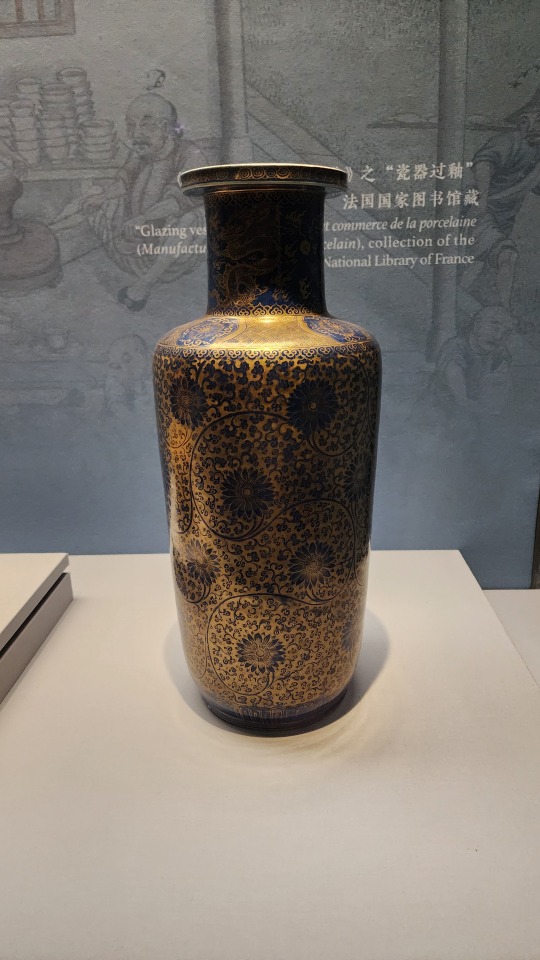
Left: a youlihong/釉里红 vessel that's shaped like an apple, so it's quite literally named a pingguozun/苹果尊. This shape is rather unique to the Kangxi era. Youlihong (lit: "red inside glaze") is basically a red copper oxide underglaze.
Middle: a youlihong vase made in the Yongzheng era.
Right: a larger vase made in the Yongzheng era that combines qinghua underglaze and youlihong underglaze in one piece.

This giant qinghua vase from the Qianlong era of Qing dynasty (1736 - 1795) was made in the shape of Shang and Zhou dynasty ancient bronze ritual vessel named gu/觚. This is also one of the few pieces produced in history that had the name of the potter attached to it. The potter who made this vase was Tang Ying/唐英, and he was the superintendent who oversaw imperial porcelain production in Jingdezhen/景德镇 (basically the Ming and Qing dynasty guan kiln) during the Yongzheng era and the Qianlong era. Together with the Kangxi era, these three Qing dynasty eras are collectively called "清三代", or "the three Qing generations (of emperors)", this was the second height of porcelain making in Chinese history after the "five great kilns"/"五大窑" of Song dynasty.

A column shaped openwork fencai/粉彩 incense holder from Qianlong era, where fencai is basically overglaze enamel decoration that falls under famille rose.

Left: a Qianlong era green fencai vase that feature kaiguang/开光, which were window or panel-like designs on the piece where scenes may be painted. This particular vase also displays poetry by Qianlong Emperor himself.
Middle: a fencai shuanglianping/双联瓶 made during the Jiaqing era of Qing dynasty (1796 - 1820). Shuanglianping are conjoined vases that symbolize the coming together of matching talents or generally good things.
Right: a Qianlong era gourd-shaped doucai/斗彩 vase with kaiguang. Doucai combines both underglaze decorations and overglaze decorations.

I want to draw special attention to this leaf-shaped fencai cup in the middle that was made in the Guangxu era of Qing dynasty (1875 - 1908). The "leaf" part is actually a lotus flower, but the cool thing about it is that the green stem part is a built-in straw, so this is a highly decorative porcelain straw cup. I really do hope there are cheaper modern replicas of this cup sold somewhere, I want one
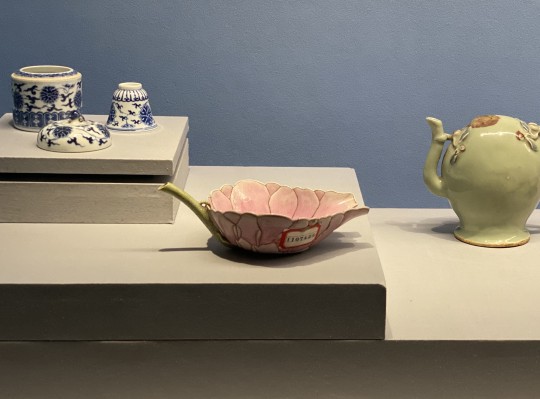
Finally, to wrap up this exhibition, here's an arrangement to show how these different porcelain pieces would be utilized in a traditional study room.

#2024 china#beijing#china#national museum of china#chinese porcelain#chinese art#chinese history#chinese culture#porcelain#ceramics#art#culture#history
103 notes
·
View notes
Text

Wild Meta Knight!!!
I figured since we see him in Winter Horns, he should have a snow leopard's pelt. I didn't really know what to do with his cape so I left it as is, it'd probably look a lot dirtier and messed up if I did a proper drawing instead of a sketch. If I do a proper drawing, I'll make his skull pauldrons look a lot more distressed, his war paint look a little less clean and uneven and the fins of his mask cracked so that it resembles bone shards!
Can I rant a little? I love Meta Knight's appearance in FL but it felt like...such a let down. Yes, yes I know having you fight your friends because they've become possessed by some malevolent but...
I WANTED MY WILD META KNIGHT BOSS!!!! I WANTED IT! I WANTED IT! I WANTED ITーーーー!!!!!
It's annoying that Meta Knight was sent to the Arena prison and barely does dick outside of it. I wanted to fight him in Winter Horns.
Anyways, how would such a boss fight go? Well, let me tell you. Have you ever played MGS3? If you haven't, you should. If you have, you should know about The Boss and her fight. I would want something similar to that. Wherein, Meta Knight stalks you flies out to land a hit on you (this is where you can strike unless you have the Ranger ability) before flying off to try recoup before repeating again. He starts off flying from high perches (which, again, if you have Ranger, you can shoot him from these perches), to lower perches, to behind rocks and boulders as he weakens. It would be far less extravagant as his previous boss fights because there's an element of stealth to it. I think his boss fight would be a slower, more tense version of the VS. Meta Knight theme from Super Star using heavy drums and flutes. Oh, and during the boss it's snowing and coming down HARD which provides cover for both you and Meta Knight. As for his more primal second phase, similar to Forgo Dedede, Forgo Meta Knight would literally go feral throwing all that he can at you. He does things like falcon punching you. Not like that falcon punch, but the kinds of punches that actual Falcons do. He'll fly as possible into the sky until you cannot see him, and the only clue you get is a shadow that grows large until you either dodge him attempting to kick you at mach speeds as he dives directly at you or you get sent flying by said kick. I also like to think Meta Knight will do a literal sonar screech, similar to Morpho Knight's Sukhavati Scale Wave that disorientates you leaving you vulnerable to an attack!
36 notes
·
View notes
Text

Kothar-wa-Khasis, They(plural)/He, Divine Artificer.
Two beings of craftsmanship become one out of love. Love for the craft. They were one of Baal Hadad's closest friends and created his palace, just like they did many other palaces before as divine architect. They also forged the weapons Ame-no-Nuboko (Izanagi's and Izanami's spear), the swords Yagarrish and Ayyamarri which were wielded by Anat.
The work they left behind after the collapse of the Old World are what inspired Marx to pursue the creation of the Clockwork Stars and Master Wings and aided Xandos in the creation of the Master Crown. They currently reside in Sukhavati, viewing all events that unfold from a neutral perspective. Long ago they gave Pidray, Tallay and Arsay advice when it came to processing their father's crimes, which lead to Arsay seeking out revenge and Tallay siding with Baal, while Pidray remained by Izanagi's side.
62 notes
·
View notes
Text

I'm always a sucker for a grim reaper type character and Morpho Knight is no exception tbh. I gave them a different style of armor (Indian) to match with the constant references to Sukhavati in their attack names and to further distinguish them from the other knight-type characters.
138 notes
·
View notes
Text

The Four Noble Truths
Buddha taught this at his first teaching.
1 - Life is suffering
Life is suffering and will remain so as long as one refuses to recognize its true nature.
People understood that they suffered, of course, but believed this was an unavoidable aspect of living. Buddha explained that it was not but arose from the skandhas (Sanskrit for "heaps" or "aggregates") which he identified as "the five aggregates of attachment" and further as "the five aggregates of suffering".
2- The cause of suffering is craving
The second truth is samudaya, meaning "origination", and addresses the cause of suffering
The cause of suffering is the craving for permanence in an impermanent world.
Believing one is a permanent entity, one constructs a false world of illusion which, because it is not real, cannot satisfy and leads to continual pain and disappointment. Buddha defines this craving as a passionate desire for things one cannot have.
3- The end of suffering comes with an end to craving
The third truth is nirodha meaning "cessation".
In order to stop craving, one must understand what one is actually craving and recognize that the illusion of permanence cannot satisfy one's needs. The end of suffering comes with an end to craving when one realizes that what one is craving is true reality, not illusions of reality Buddha encourages an abrupt stop to the craving behavior along the lines of abandoning a bad habit
4- There is a "middle way" in navigating life
The fourth truth is marga, meaning "the path", by which Buddha means his "middle way" in navigating life. He begins by simply stating that there is a path which leads one away from craving and suffering. The Noble Truth of the Path leading to the cessation of suffering is this: It is simply the Noble Eightfold Path, namely, right view; right thought; right speech; right action; right livelihood; right effort; right concentration; right mindfulness.
#buddha#buddhist#buddhism#dharma#sangha#mahayana#zen#milarepa#tibetan buddhism#thich nhat hanh#enlightenment spiritualawakening reincarnation tibetan siddhi yoga naga buddha#eight precious symbols#amitaba buddha#amitabha#sukhavati#dewachen#Namo Amituofo
59 notes
·
View notes
Text

Buddha Amitabha
The tale and genesis of Buddha Amitabha, intertwined with the essence of his very name, are profoundly woven into the fabric of Buddhist lore, especially amid the vast expanse of the Mahayana tradition. Known as the Buddha of Boundless Luminescence, Amitabha reigns as a celestial figure within the Mahayana scriptures. He stands at the heart of the Pure Land tradition, a distinctive path within Buddhism that embraces the vocal invocation of Amitabha's name in aspirations of rebirth within the blissful realms of Sukhavati. Here, in this sanctified haven, the promise of enlightenment awaits all.
The name "Amitabha" is derived from the Sanskrit words "amita," meaning "infinite," and "abha," meaning "light." Therefore, Amitabha translates to "Infinite Light," reflecting his association with the light that illuminates the entire universe, symbolising wisdom, compassion, and purity without bounds. His name means "infinite light" - amita (unmeasured, boundless, infinite) + ābha (splendour, light; colour, appearance, beauty - related to bha : light, lustre, splendour.
The Mantra OM AMI DEWA HRIH
The mantra "Om Ami Dewa Hrih" is a sacred invocation that embodies the essence and blessings of Amitabha Buddha, known for his boundless compassion and the infinite light that he represents. Here is an elucidation of its meaning, inspired by the sources we've explored:
Om: This syllable is a primordial sound, resonating with the essence of the universe. It signifies the embodiment of enlightenment, encompassing the enlightened body, speech, and mind. In our practice, it calls upon the universal energies, inviting the sacred to imbue our endeavour with grace.
Ami: This represents Amitabha Buddha himself, whose name means "Infinite Light". Amitabha's light is boundless, illuminating the darkest corners of existence and guiding beings towards liberation. In chanting "Ami", we invoke his presence, asking for his light to fill our beings, dispelling ignorance and illuminating our path.
Dewa: Symbolising the celestial realms, Dewa connects us to the transcendent qualities Amitabha embodies. It is a reminder of the potential for purity and bliss that lies within us, echoing the promise of rebirth in Amitabha's Pure Land for those who earnestly seek it. This part of the mantra helps us to align with our true nature, aspiring towards a state of divine grace and peace.
Hrih: Known as the seed syllable of compassion, Hrih is the heart of Amitabha's mantra. It embodies the essence of compassion, a fundamental attribute of Amitabha Buddha. Chanting "Hrih" nurtures our innate compassion, encouraging it to blossom fully. It is through compassion that we connect deeply with all beings, sharing in the light of Amitabha and fostering a world of kindness and understanding.
Together, "Om Ami Dewa Hrih" is a powerful mantra that not only invokes the blessings of Amitabha Buddha but also aligns us with the qualities he embodies. By chanting this mantra, we cultivate infinite light and compassion within ourselves, guiding our journey towards enlightenment and aiding in the transcendence of suffering. It is a beacon of hope, illuminating the path to the Pure Land, where peace and bliss prevail.
21 notes
·
View notes
Text
Tiny #elephant alert! 🐘



Amitabha Sutra (Discourse on the Land of Bliss), China, c.1775
The Morgan Library & Museum MS W.69
“PAINTED ON A BODHI LEAF
The Buddha achieved enlightenment beneath a tree with large, spade-shaped leaves. Revered by Buddhists, these trees became known as bodhi (or "enlightenment") trees and were propagated throughout Asia. In China, artists used bodhi leaves to create paintings for albums like this one, thereby infusing their images with sacred power. Written in gold ink against a deep blue background, this Buddhist sutra, or scripture, describes the wonders of Sukhavati, or the Land of Bliss, an uncorrupted realm inhabited by enlightened beings. One such being is depicted here accompanied by a diminutive elephant. The brightly painted bodhi leaf was pasted into a section of cutout paper and framed with yellow silk brocade.”
#animals in art#museum visit#manuscript#illuminated manuscript#miniature painting#painting#leaf painting#elephant#bohdi#Chinese art#Buddhist art#East Asian art#Asian art#18th century art#Morgan Library
31 notes
·
View notes
Text
Sun Wukong's Buddhist Paradise
Some of my followers may be familiar with my past article in which I described Xuanzang's historical itinerary and discussed what a more realistic Journey to the West might be like. Towards the end, after the pilgrims return to China with the scriptures and the disciples (Sun Wukong, Zhu Bajie, and Sha Wujing) receive their elevation in spiritual rank, I stated: “They would thereafter leave to enjoy their divine lives in the Western Paradise.” But I’ve never really liked the idea that Monkey would forever abandon his people. This is especially true since his rebellion led to heaven decimating the monkeys and burning their cave (Wu & Yu, 2012, vol. 2, p. 31).
I think a better ending for this historical version would be for the “Victorious Fighting Buddha” to return to the Mountain of Flower and Fruit, where he transforms it into his own Pure Land (Jingtu, 淨土). The monkeys killed in years passed would be reborn there, and everyone would receive periodic lessons on the dharma between bouts of play. It would be a paradise even grander than when the Great Sage was at the height of his power.
Here is some information about pure lands from the Encyclopedia of Buddhism (Gomez, 2004):


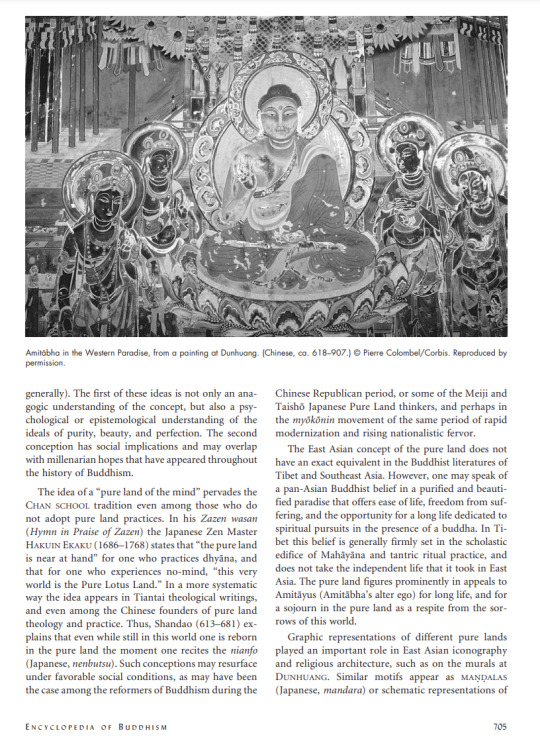
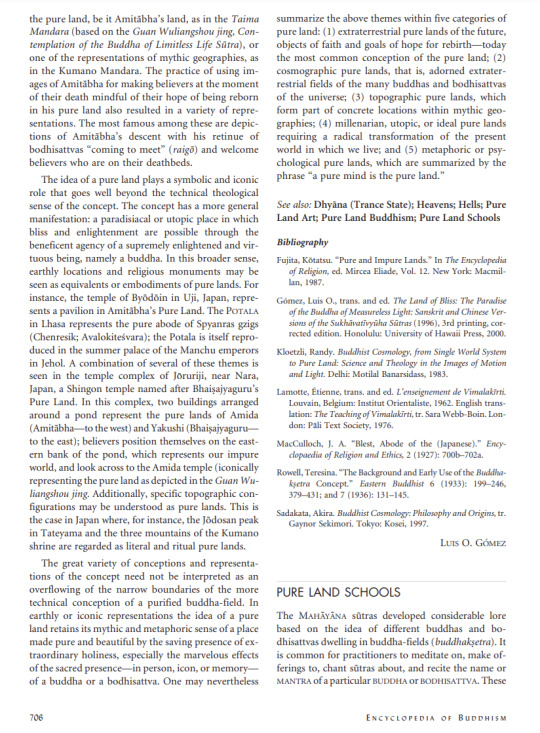
I love this circa 1700 Tibetan painting of Amitabha in his pure land of Sukhavati. Just imagine the Victorious Fighting Buddha sitting in Amitabha's place, and monkeys would take the place of the monks, protectors, and devas.

Sources:
Gomez, O. L. (2004). Pure Lands. In R. E. Buswell (Ed.), Encyclopedia of Buddhism (pp. 703-706) (Vols. 2). United Kingdom: Macmillan Reference, USA.
Wu, C., & Yu, A. C. (2012). The Journey to the West (Vols. 1-4). Chicago, Illinois: University of Chicago Press.
#sun wukong#monkey king#journey to the west#buddhism#Pure land#amitabha#Victorious Fighting Buddha#Buddha Victorious in Strife#Lego Monkie Kid#LMK#JTTW#dharma
87 notes
·
View notes